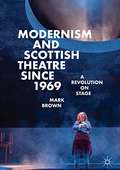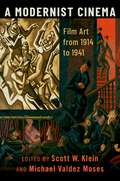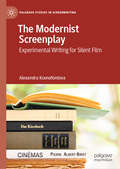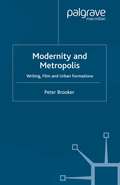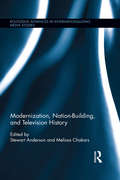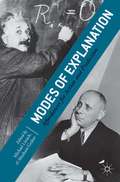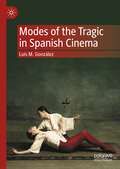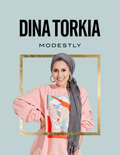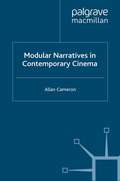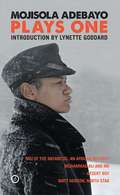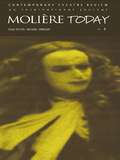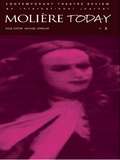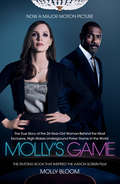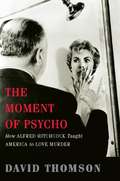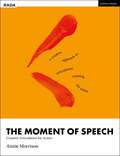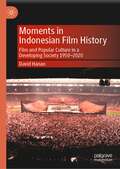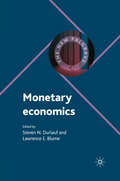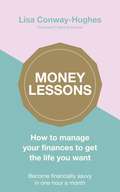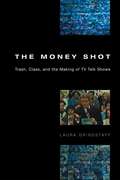- Table View
- List View
Modernism and Scottish Theatre since 1969: A Revolution on Stage
by Mark BrownThis book argues that Scottish theatre has, since the late 1960s, undergone an artistic renaissance, driven by European Modernist aesthetics. Combining detailed research and analysis with exclusive interviews with ten leading figures in modern Scottish drama, the book sets out the case for the last half-century as the strongest period in the history of the Scottish stage. Mark Brown traces the development of Scottish theatre’s Modernist revolution from the arrival of influential theatre director Giles Havergal at the Citizens Theatre, Glasgow in 1969 through to the advent of the National Theatre of Scotland in 2006. Finally, the book contemplates the future of Scotland’s theatrical renaissance. It is essential reading for anyone interested in contemporary theatre and/or the modern history of live drama in Scotland.
A Modernist Cinema: Film Art from 1914 to 1941
by Scott W. Klein and Michael Valdez MosesIn A Modernist Cinema, sixteen distinguished scholars in the field of the New Modernist Studies explore the interrelationships among modernism, cinema, and modernity. Focusing on several culturally influential films from Europe, America, and Asia produced between 1914 and 1941, this collection of essays contends that cinema was always a modernist enterprise. Examining the dialectical relationship between a modernist cinema and modernity itself, these essays reveal how the movies represented and altered our notions and practices of modern life, as well as how the so-called crises of modernity shaped the evolution of filmmaking. Attending to the technical achievements and formal qualities of the works of several prominent directors - Giovanni Pastrone, D. W. Griffith, Sergei Eisenstein, Fritz Lang, Alfred Hitchcock, F. W. Murnau, Carl Theodore Dreyer, Dziga Vertov, Luis Buñuel, Yasujiro Ozu, John Ford, Jean Renoir, Charlie Chaplin, Leni Riefenstahl, and Orson Welles - these essays investigate several interrelated topics: how a modernist cinema represented and intervened in the political and social struggles of the era; the ambivalent relationship between cinema and the other modernist arts; the controversial interconnection between modern technology and the new art of filmmaking; the significance of representing the mobile human body in a new medium; the gendered history of modernity; and the transformative effects of cinema on modern conceptions of temporality, spatial relations, and political geography.
A Modernist Cinema: Film Art from 1914 to 1941
In A Modernist Cinema, sixteen distinguished scholars in the field of the New Modernist Studies explore the interrelationships among modernism, cinema, and modernity. Focusing on several culturally influential films from Europe, America, and Asia produced between 1914 and 1941, this collection of essays contends that cinema was always a modernist enterprise. Examining the dialectical relationship between a modernist cinema and modernity itself, these essays reveal how the movies represented and altered our notions and practices of modern life, as well as how the so-called crises of modernity shaped the evolution of filmmaking. Attending to the technical achievements and formal qualities of the works of several prominent directors - Giovanni Pastrone, D. W. Griffith, Sergei Eisenstein, Fritz Lang, Alfred Hitchcock, F. W. Murnau, Carl Theodore Dreyer, Dziga Vertov, Luis Buñuel, Yasujiro Ozu, John Ford, Jean Renoir, Charlie Chaplin, Leni Riefenstahl, and Orson Welles - these essays investigate several interrelated topics: how a modernist cinema represented and intervened in the political and social struggles of the era; the ambivalent relationship between cinema and the other modernist arts; the controversial interconnection between modern technology and the new art of filmmaking; the significance of representing the mobile human body in a new medium; the gendered history of modernity; and the transformative effects of cinema on modern conceptions of temporality, spatial relations, and political geography.
The Modernist Screenplay: Experimental Writing for Silent Film (Palgrave Studies in Screenwriting)
by Alexandra KsenofontovaThe Modernist Screenplay explores the film screenplay as a genre of modernist literature. It connects the history of screenwriting for silent film to the history of literary modernism in France, Germany, and Russia. At the same time, the book considers how the screenplay responded to the modernist crisis of reason, confronted mimetic representation, and sought to overcome the modernist mistrust of language with the help of rhythm. From the silent film projects of Bertolt Brecht, to the screenwriting of Sergei Eisenstein and the poetic scripts of the surrealists, The Modernist Screenplay offers a new angle on the relationship between film and literature. Based on the example of modernist screenwriting, the book proposes a pluralistic approach to screenplays, an approach that sees film scripts both as texts embedded in film production and as literary works in their own right. As a result, the sheer variety of different and experimental ways to tell stories in screenplays comes to light. The Modernist Screenplay explores how the earliest kind of experimental screenplays—the modernist screenplays—challenged normative ideas about the nature of filmmaking, the nature of literary writing, and the borders between the two.
Modernity and Metropolis: Writing, Film and Urban Formations
by P. BrookerA study of urban identity and community looks at selected twentieth century literary and film texts in the context of theorizations of modernism, postmodernism, postcoloniality and globalization. Brooker draws on Beck and Giddens to propose a 'reflexive modernism' which rewrites and re-imagines the urban scene. The principal cities considered are London and New York, Tokyo, Hong Kong and Bangkok. Writers considered include Ezra Pound and T.S. Eliot, Langston Hughes, Hanif Kureishi, Iain Sinclair, Paul Auster, Sarah Schulman and William Gibson. Filmmakers include Patrick Keiller and Wong Kar-Wai.
Modernization, Nation-Building, and Television History (Routledge Advances in Internationalizing Media Studies)
by Stewart Anderson Melissa ChakarsThis innovative collection investigates the ways in which television programs around the world have highlighted modernization and encouraged nation-building. It is an attempt to catalogue and better understand the contours of this phenomenon, which took place as television developed and expanded in different parts of the world between the 1950s and the 1990s. From popular science and adult education shows to news magazines and television plays, few themes so thoroughly penetrated the small screen for so many years as modernization, with television producers and state authorities using television programs to bolster modernization efforts. Contributors analyze the hallmarks of these media efforts: nation-building, consumerism and consumer culture, the education and integration of citizens, and the glorification of the nation’s technological achievements.
Modernization, Nation-Building, and Television History (Routledge Advances in Internationalizing Media Studies)
by Stewart Anderson Melissa ChakarsThis innovative collection investigates the ways in which television programs around the world have highlighted modernization and encouraged nation-building. It is an attempt to catalogue and better understand the contours of this phenomenon, which took place as television developed and expanded in different parts of the world between the 1950s and the 1990s. From popular science and adult education shows to news magazines and television plays, few themes so thoroughly penetrated the small screen for so many years as modernization, with television producers and state authorities using television programs to bolster modernization efforts. Contributors analyze the hallmarks of these media efforts: nation-building, consumerism and consumer culture, the education and integration of citizens, and the glorification of the nation’s technological achievements.
Modes of Explanation: Affordances for Action and Prediction
by Michael Lissack Abraham GraberModes of Explanation is the first book in decades to attempt to bring these conflicting approaches together and to offer a compelling narrative to explore how the paradox of 'explanation' can converge.
Modes of the Tragic in Spanish Cinema
by Luis M. GonzálezThis book focuses on expressions of the tragic in Spanish cinema. Its main premise is that elements from the classical and modern tragic tradition persist and permeate many of the cultural works created in Spain, especially the films on which the book centers this study. The inscrutability and indolence of the gods, the mutability of fortune, the recurrent narratives of fall and redemption, the unavoidable clash between ethical forces, the tension between free will and fate, the violent resolution of both internal and external conflicts, and the overwhelming feelings of guilt that haunt the tragic heroine/hero are consistent aspects that traverse Spanish cinema as a response to universal queries about human suffering and death.
Modestly
by Dina Torkia“I defy any woman to flick through Modestly, through Dina’s musings on bullying, eating disorders, maternity wear, contouring and feminism, and not find something they can relate to” – METRO ‘This is the story of my life. It’s about me as a Muslim Brit embracing dual identities, surviving the turbulent teens and transitioning from self-doubt to self-belief. There is a little bit of drama, lots of laughs, plenty of practical advice and a shedload of bold statements. You can’t get a Muslim woman in a hijab with no opinion, am I right?!' Dina x Guys, get ready. YouTuber and social media sensation Dina Torkia is giving you a never-seen-before look into her world. From advice on fashion, beauty and style, to frank opinions on family, career and faith, this is everything that Dina has ever wanted to share with you. So let Dina tell you how it really is, living and loving life as a modern Muslim Brit. @dinatokio
Modular Narratives in Contemporary Cinema
by A. CameronSince the early 1990s there has been a trend towards narrative complexity within popular cinema. This book examines a number of contemporary films that play overtly with narrative structure, raising questions of chance and destiny, memory and history, simultaneity and the representation of time.
Mojisola Adebayo: Plays One (Oberon Modern Playwrights)
by Mojisola AdebayoIncludes the plays Moj of the Antarctic, Desert Boy, Matt Henson: North Star and Muhammad Ali and MeThis collection signals the emergence of a distinctive new voice on the British theatre landscape. Moj of the Antarctic is inspired by the true story of an African American woman who cross-dresses as a white man to escape slavery; taken on a fantastical odyssey to Antarctica. Time Out Critics’ Choice‘The language is rich and densely poetic. Reveling in the materiality and playfulness of words, cracking open complex ideas like eggshells.’ - Total Theatre MagazineMuhammad Ali and Me is a lyrical coming of age story, following the parallel struggles of a gay girl child growing up in foster care and the black Muslim boxing hero’s fight against racism and the Vietnam war.‘As a piece of stagecraft, an entertaining kaleidoscope of social and political history, only one description will do: this is a play that ‘floatslike a butterfly and stings like a bee.’ - WhatsOnStageDesert Boy, a time-travelling a capella musical, offers a sharp twist on the subject of knife crime, black youth and absent fathers.‘…a spiralling journey through colonial history not unlike Dante’s introduction to the Inferno. The juxtapositions are sometimes startling, and often quite comic.’ - Guardian Matt Henson, North Star is a biographical tale of Arctic betrayal, mixed with Greenlandic folk tales; all about love, climate and change.These plays queer the boundaries of sex and race, fact and fiction, history and geography, poetry and politics to illuminate contemporary themes through a dynamic African Diasporic theatrical aesthetic that leaps off the page.
Moliere Today 1
by Michael SpinglerThis collection focuses on Moliere's theatre as works to be performed as well as read. The essays deal in their various ways with limits which are imposed and respected or violated and broken. The question of transgression both as a subject within Moliere's plays and as a dilemma confronting Moliere's critics and interpreters is addressed. The book aims to enlarge the scope of academic scholarship and include the thinking and insights of actors.
Moliere Today 1
by Michael SpinglerThis collection focuses on Moliere's theatre as works to be performed as well as read. The essays deal in their various ways with limits which are imposed and respected or violated and broken. The question of transgression both as a subject within Moliere's plays and as a dilemma confronting Moliere's critics and interpreters is addressed. The book aims to enlarge the scope of academic scholarship and include the thinking and insights of actors.
Moliere Today 2
by Michael SpinglerThe refusal on the part of academic critics to recognize the primacy of farce in Moliere's theatre is contradicted by wide spread theatrical pracitce. These essays develop the argument that Moliere needs to be rescued from the pantheon of classical literature and put back on the Pont-Neuf with the strolling players, low-life rogues, cut-purses and clowns with whom he filled his theatre.
Moliere Today 2
by Michael SpinglerThe refusal on the part of academic critics to recognize the primacy of farce in Moliere's theatre is contradicted by wide spread theatrical pracitce. These essays develop the argument that Moliere needs to be rescued from the pantheon of classical literature and put back on the Pont-Neuf with the strolling players, low-life rogues, cut-purses and clowns with whom he filled his theatre.
Molly’s Game: From Hollywood's Elite To Wall Street's Billionaire Boys Club, My High-stakes Adventure In The World Of Underground Poker
by Molly BloomA SUNDAY TIMES BESTSELLER NOW A MAJOR MOTION PICTURE WRITTEN AND DIRECTED BY AARON SORKIN, AND STARRING JESSICA CHASTAIN, IDRIS ELBA, KEVIN COSTNER AND MICHAEL CERA The true story of the 26-year-old woman behind the most exclusive, high-stakes underground poker game in the world
The Moment of Psycho: How Alfred Hitchcock Taught America to Love Murder
by David ThomsonIt was made like a television movie, and completed in less than three months. It killed off its star in forty minutes. There was no happy ending. And it offered the most violent scene to date in American film, punctuated by shrieking strings that seared the national consciousness. Nothing like Psycho had existed before; the movie industry—even America itself—would never be the same.In The Moment of Psycho, film critic David Thomson situates Psycho in Alfred Hitchcock&’s career, recreating the mood and time when the seminal film erupted onto film screens worldwide. Thomson shows that Psycho was not just a sensation in film: it altered the very nature of our desires. Sex, violence, and horror took on new life. Psycho, all of a sudden, represented all America wanted from a film—and, as Thomson brilliantly demonstrates, still does.
The Moment of Psycho: How Alfred Hitchcock Taught America to Love Murder
by David ThomsonIt was made like a television movie, and completed in less than three months. It killed off its star in forty minutes. There was no happy ending. And it offered the most violent scene to date in American film, punctuated by shrieking strings that seared the national consciousness. Nothing like Psycho had existed before; the movie industry -- even America itself -- would never be the same. In The Moment of Psycho, film critic David Thomson situates Psycho in Alfred Hitchcock's career, recreating the mood and time when the seminal film erupted onto film screens worldwide. Thomson shows that Psycho was not just a sensation in film: it altered the very nature of our desires. Sex, violence, and horror took on new life. Psycho, all of a sudden, represented all America wanted from a film -- and, as Thomson brilliantly demonstrates, still does.
The Moment of Speech: Creative Articulation for Actors (RADA Guides)
by Annie MorrisonAnnie Morrison, creator of the Morrison Bone Prop, abandons the notion that language and thought are mainly processed in the left cerebral hemisphere, and coaches the actor to speak from the heart. Through this method, words acquire physical properties, such as weight, texture, colour and kinetic force. Think about Martin Luther King, Mao Zedong or Malala Yousafzai; potent speech impacts external events. And internally, it forms and shapes the world of the speaker. Seeing articulation as a purely mechanical skill is detrimental to an actor's process: it is crucial to understand what language is doing on a biological level. This workbook is invaluable for actors, both professional and in training, and also for voice and speech teachers.
The Moment of Speech: Creative Articulation for Actors (RADA Guides)
by Annie MorrisonAnnie Morrison, creator of the Morrison Bone Prop, abandons the notion that language and thought are mainly processed in the left cerebral hemisphere, and coaches the actor to speak from the heart. Through this method, words acquire physical properties, such as weight, texture, colour and kinetic force. Think about Martin Luther King, Mao Zedong or Malala Yousafzai; potent speech impacts external events. And internally, it forms and shapes the world of the speaker. Seeing articulation as a purely mechanical skill is detrimental to an actor's process: it is crucial to understand what language is doing on a biological level. This workbook is invaluable for actors, both professional and in training, and also for voice and speech teachers.
Moments in Indonesian Film History: Film and Popular Culture in a Developing Society 1950–2020
by David HananThis book explores Indonesian cinema, focusing on moments of unique creativity by Indonesian film artists who illuminate important but less-widely-known aspects of their multi-dimensional society. It begins by exploring early 1950s ‘Indonesian neorealist films’ of the Perfini group, which depict the ethos and emerging moral issues of the period of struggle for independence (1945–49). It continues by discussing four audacious political allegories produced in four discrete political eras—including the Sukarno, Suharto and Reformasi periods. It also surveys the main approaches to Islam in both popular cinema and auteur films during the Suharto New Order. One chapter celebrates the popular songs and B-movies of the Betawi comedian, Benyamin S, which dramatize the experience of the poor in ‘modernizing’ Jakarta. Another examines persisting Third World dimensions of Indonesian society as critiqued in two experimental features. The concluding chapter highlights innovation in a renewed Indonesian cinema of the post-Suharto Reformasi period (1999–2020), including films by an unprecedented generation of women writer-directors
Monetary Economics (The New Palgrave Economics Collection)
by Steven Durlauf L. BlumeSpecially selected from The New Palgrave Dictionary of Economics 2nd edition, each article within this compendium covers the fundamental themes within the discipline and is written by a leading practitioner in the field. A handy reference tool.
Money Lessons: How to manage your finances to get the life you want
by Lisa Conway-HughesIf you spent one hour a month nurturing your finances for the next twelve months, how would you feel this time next year, what would be different? Mapping out a plan for achieving your big goals and managing everyday spending, Money Lessons is your own pocket financial expert. Whether you have it or not, money is often as difficult to talk about as it is to handle. Many of us will at one point need advice on how to:- ask for a pay rise- save up to buy a place- pay for a mortgage- finance a career move- budget for a wedding- fund a big trip- get out of debt- retire comfortablyBuilding on her 15 years of experience helping countless people to make smart financial decisions, Lisa Conway-Hughes tackles these topics in a short guide to being savvy and getting what you want in every stage of your life. Full of expert knowledge and success stories, this is essential reading for anyone who wants to turn a dream into a plan - and eventually a reality.
The Money Shot: Trash, Class, and the Making of TV Talk Shows
by Laura GrindstaffHe leaped from his chair, ripped off his microphone, and lunged at his ex-wife. Security guards rushed to intercept him. The audience screamed, then cheered. Were producers concerned? Not at all. They were getting what they wanted: the money shot. From "classy" shows like Oprah to "trashy" shows like Jerry Springer, the key to a talk show's success is what Laura Grindstaff calls the money shot—moments when guests lose control and express joy, sorrow, rage, or remorse on camera. In this new work, Grindstaff takes us behind the scenes of daytime television talk shows, a genre focused on "real" stories told by "ordinary" people. Drawing on extensive interviews with producers and guests, her own attendance of dozens of live tapings around the country, and more than a year's experience working on two nationally televised shows, Grindstaff shows us how producers elicit dramatic performances from guests, why guests agree to participate, and the supporting roles played by studio audiences and experts. Grindstaff traces the career of the money shot, examining how producers make stars and experts out of ordinary people, in the process reproducing old forms of cultural hierarchy and class inequality even while seeming to challenge them. She argues that the daytime talk show does give voice to people normally excluded from the media spotlight, but it lets them speak only in certain ways and under certain rules and conditions. Working to understand the genre from the inside rather than pass judgment on it from the outside, Grindstaff asks not just what talk shows can tell us about mass media, but also what they reveal about American culture more generally.
